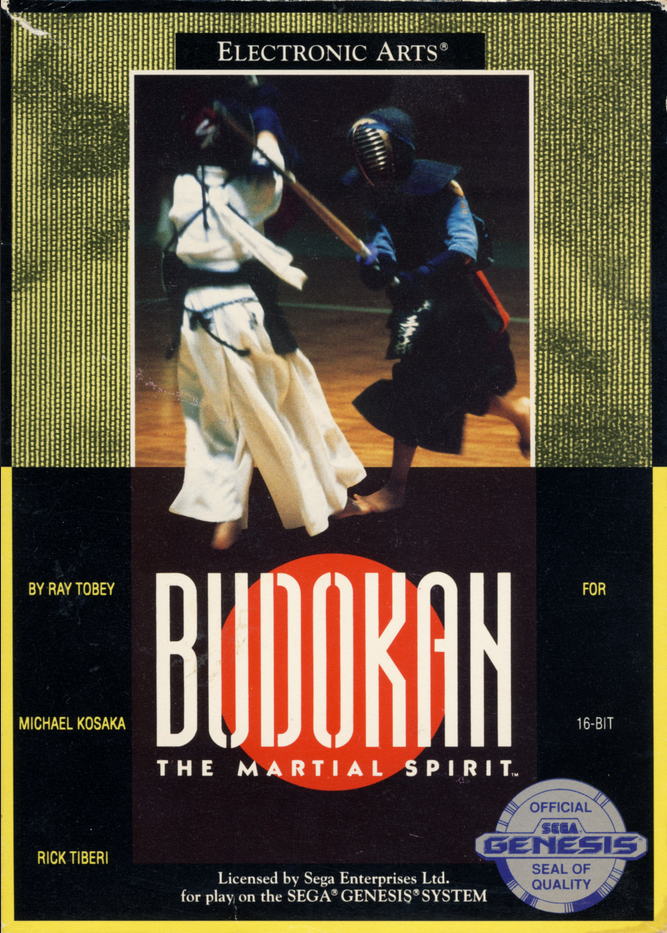
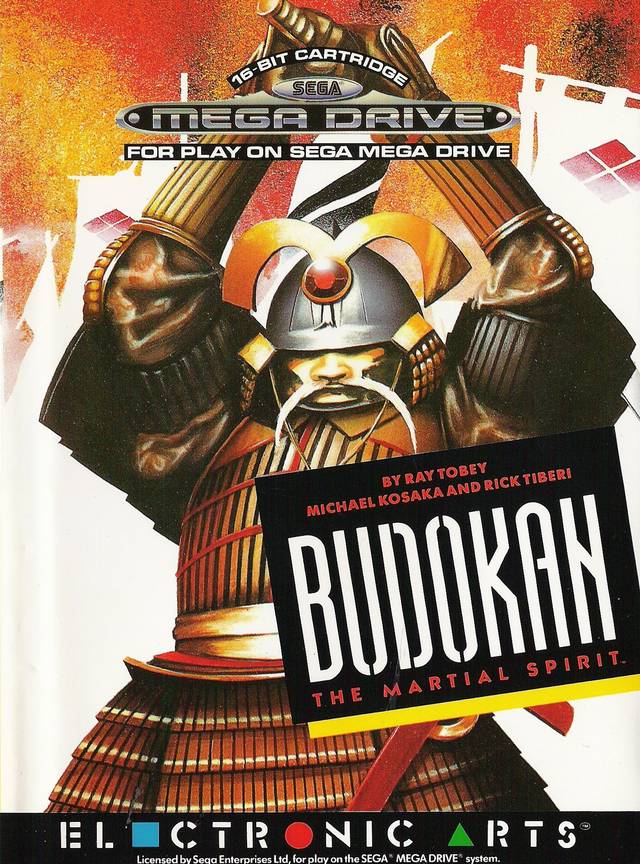
PLAYERS: 1-2 simultaneous
PUBLISHER/DEVELOPER: Electronic Arts
GENRE: Fighting
RELEASE DATE: 07/90 – (US), 12/90 – (EU)
Budokan: The Martial Spirit is a technical fighting game, so woe be to you if you approach it expecting quick pick-up-and-play fisticuffs. Developed and published by Electronic Arts for computers in 1989 before being ported to the Genesis in 1990, Budokan arrived in a pre-Street Fighter II world. And if you’ve played any fighting game released prior to that seminal 1991 classic – Yie Ar Kung Fu, Karate Champ, the original Street Fighter – you know you’re in for some awkward, uncomfortable bouts.
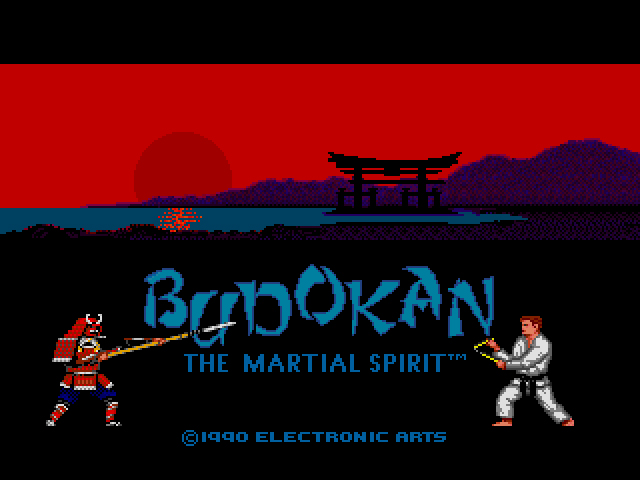
Like the aforementioned titles, Budokan just feels off. Your martial artist moves slow, attacks slow, and blocks slow. His geriatric movements are likely due to the game’s realistic approach. Karate and kendo are the combat methods, while the bo and nunchaku are your weapons of choice. At no point will you execute upside down whirlwind kicks or shred your opponents’ chests with sharp American hair. And that’s fine! There’s nothing wrong with strict realism. But when your character – the only one the game gives you – controls like a slug on holiday, don’t expect to win many matches.
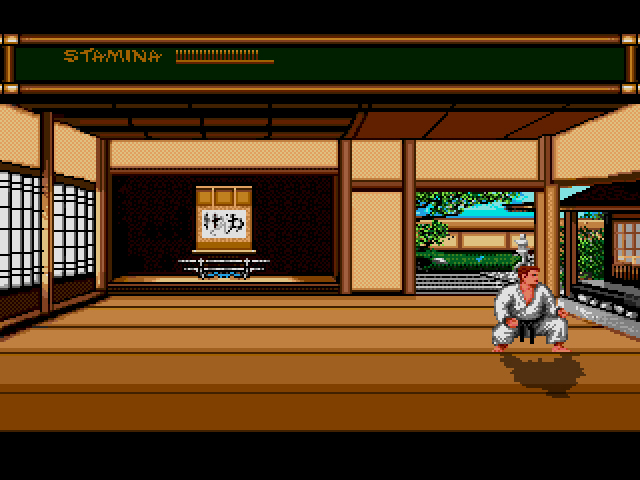
You begin the game at the Tobiko-Ryu Dojo, where you can practice any of the four techniques the game wants you to learn. Karate, kendo, bo, and nunchaku all have their own training areas, and you can practice both by yourself and alongside an opponent of differing skill. Kendo and nunchaku are the best combat method and weapon respectively, if only for their long range and powerful hits. The bo has good range, but its attack is slower than the nunchaku. Karate is the worst, as it forces you to attack from close range and only offers weak attacks.
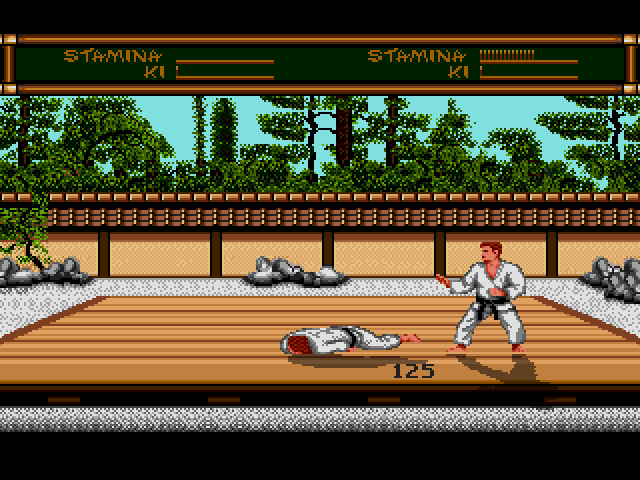
You can fight shadows by your lonesome all you want, but the real test comes when you face an opponent. Both you and your opponent have a Stamina and Ki bar. Stamina is your life bar and is drained by moving and attacking, and replenished by standing still. Ki increases your strength, though it’s constantly being drained by your attacks and by getting hit. The more Ki you have, though, the stronger your attacks will be. When you or your combatant’s stamina is drained, the match is over. Your teacher will then tell you how you performed and give you tips on how to improve.
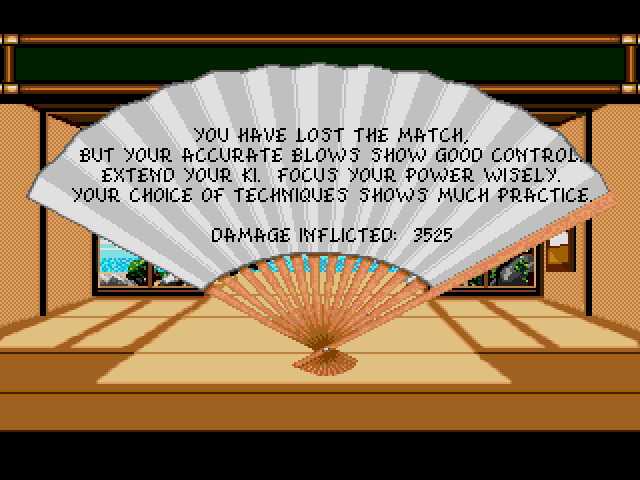
Attacks are difficult to execute for three reasons:
Reason 1: Your fighter is slow. Seriously, why can’t he move faster?
Reason 2: Attacks are tied in to your stamina. If your stamina is low, your ability to attack with strong moves decreases. Yes, it’s realistic. The game wants you to consider each move before you make it. Unfortunately, the computer-controlled opponents don’t care about your considerations and will move in for the kill given the chance. Their stamina bar also decreases much slower than yours.
Reason 3: The game demands precise inputs. Your attack buttons are A, B, and C, but pressing them alone doesn’t accomplish anything. A High Punch using Karate is executed by pressing Forward, Up, and an Attack button. Is the High Punch worth this effort? Yes and no. Any attack will drain stamina off an opponent. Most of them, including the High Punch, are so dang tedious to pull off that it’s better to just learn a couple strong moves and spam the heck out of them. Just like the Budokan Warriors of old.
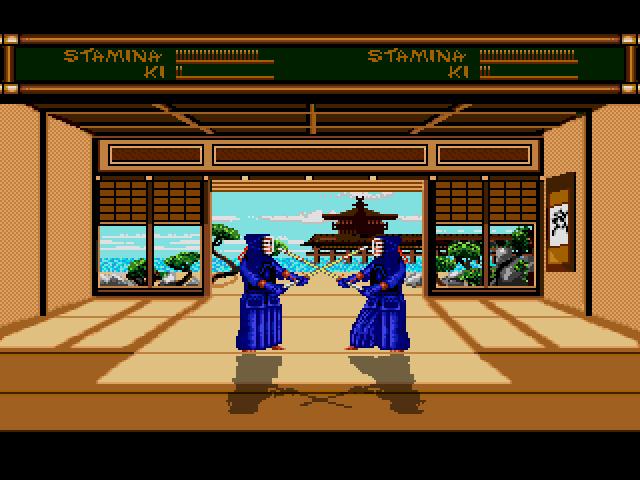
Blocking takes even more skill than attacking. In order to block properly, you must time your blocks with the enemy’s attacks, which are considerably faster than your movements will ever be. Blocking properly does result in your Ki being restored, though, so there’s incentive to learn if you’re willing to struggle.
After you’ve diddled around in the dojo for awhile, pack your bags and head to the Budokan arena in Tokyo for twelve incredibly challenging matches. Each opponent has a small biography that alludes to the type of combat or weapon you should use to fight them. Karate, Kendo, Bo, and Nunchaku can only be used four times each during the entire tournament, so don’t think you can just strap on a Kendo outfit and dominate all twelve rounds. Make it through each fight alive and you’ll become the Nippon Budokan Champion.
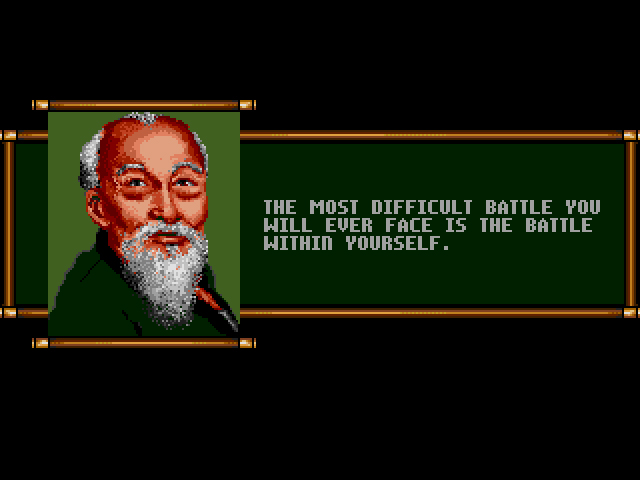
The first warrior you face is Goro Suzuki, a man known more for his love of sushi than his karate skills. You could have fooled me. One close match aside, Goro destroyed me every time I challenged him. I pulled every dirty trick in the book too. I jump kicked his head a couple times in a row. I pushed him out-of-bounds several times, which drained a bit off his Stamina and Ki. I kicked him in the groin. I also pulled off the Budokan special: standing motionless like an idiot, while yelling at the controller for not responding to my button presses. I never got past Goro which means I never saw the other eleven opponents which means I pretty much suck at Budokan.
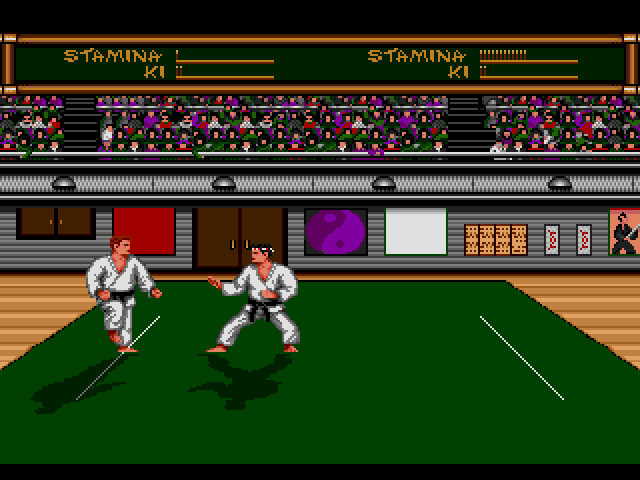
It’s a shame Budokan has such an impossible learning curve. Programmer Ray Tobey and designer Michael Kosaka do an excellent job in immersing you into the game’s world. The dojo is a delicately crafted, peaceful place, with each training center distinct from the others. In the background of the Karate center, for example, a blue bird sits atop a pedestal before swooping down onto the ground to forage for food. A cutscene that shows your bullet train journey from the humble dojo to the impressive Budokan arena feels appropriately heavy. Your opponents’ distinct backgrounds and personalities also make them seem like real challengers rather than untouchable demigods.
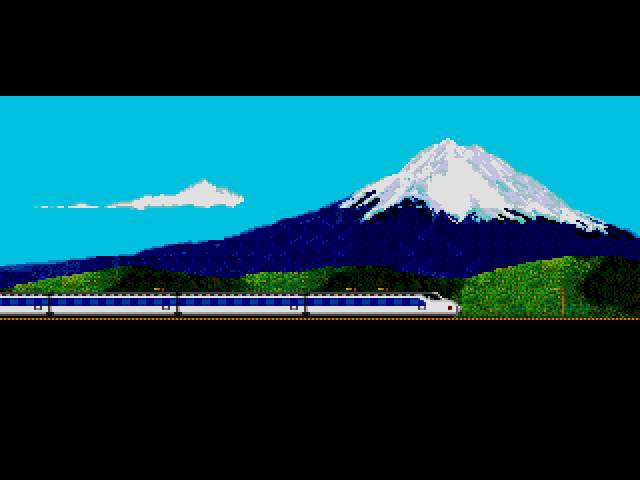
Budokan‘s clunky controls has to be a result of the transition from computer to console. Playing this with a keyboard might not make the combat any less unwieldy, but at least you could assign moves to different keys. The Genesis controller, with its stiff D-pad and three face buttons, can’t handle such technical and precise combat.
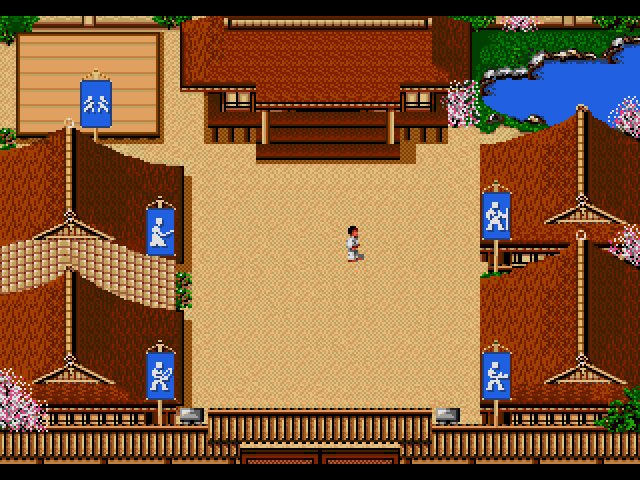
The only way you can play Budokan on the Genesis these days is if you have an early Model 1. Sega’s TradeMark Security System (TMSS) was implemented in later Model 1 revisions and all Genesis 2 and 3 models. Created to lock out unlicensed games, the TMSS only allows games with the word “Sega” in different sections of the game’s code to boot properly. For reasons unknown, early Electronic Arts games produced for the Genesis skip the steps required to satisfy the system.
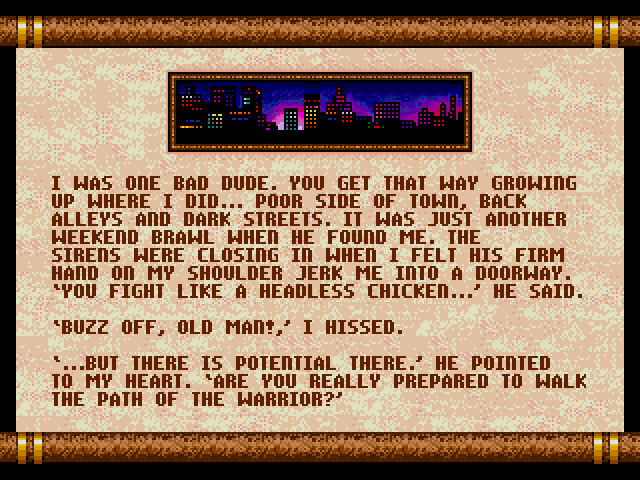
Like the martial artist you portray, Budokan has potential and that’s what makes the game so frustrating. The content is there – four separate skills to master, twelve opponents to eliminate – but the molasses movements and complex inputs just don’t work outside of a keyboard. That’s a shame. There’s a seed of a great technical fighter buried within the Genesis port’s limitations, but whose Martial Spirit is patient and willing enough to nurture it?
D+

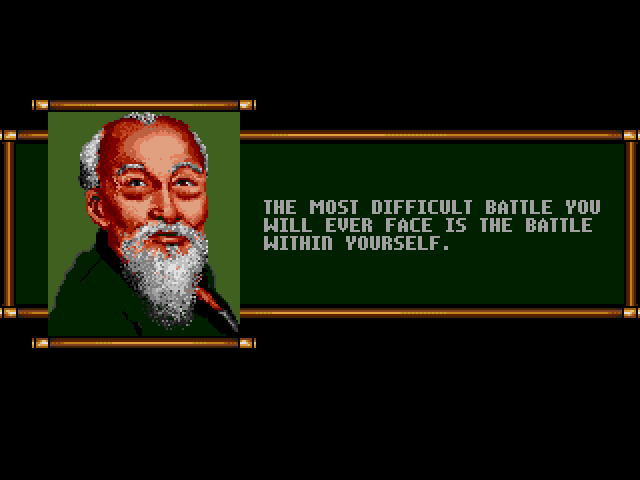
15 replies on “Budokan: The Martial Spirit (Genesis, 1990)”
I believe this was Electronic Arts’ grand entry into the Sega realm, this and Populous, after being dragged kicking and screaming into the video game realm.
Indeed. Not sure which came first, but both were incredibly early.
EA, along with Accolade, weren’t Sega licensees at first, and learned how to program for the Genesis using reverse engineering. While Accolade got sued (and eventually settled with Sega), EA simply used the tactic to get more favorable terms. IIRC, some games by the two companies (and even some games by Sega that had left out TMSS support) were reissued later on to work with TMSS-enabled systems, so it says something that EA didn’t reissue this game.
It’s a shame the game is trash, because it looks absolutely beautiful in those screen shots.
I played Budokan recently on EA Play, EA’s PSP Mega Drive collection. It seemed an odd game to put on the compilation, given it’s age and obscurity – there is no Populous, Theme Park or Mutant League Hockey, for example . That it was never reissued would allude to EA knowing Budokan wouldn’t do well in the world of Streetfighter and Mortal Kombat.
As you say though, Budokan is far too realistic for it’s own good. Imagine a soccer game where you have to drive the coach to games, ensure you have the correct kit then complete a full warm up every game…The level of detail is great, but it would take far too much effort to enjoy.
The most interesting thing about Budokan in my opinion is it’s status as an early EA game. Looking back now, knowing EA like we do in 2017, is anyone else surprised that EA took on SEGA, reverse engineered the Mega Drive and threatened to release their unapproved but technically legal games? Bukodan was an EA Amiga game that was quickly ported to Mega Drive – like Populous, Zany Golf (two games that also only work on original MD1s), Fatal Rewind, The Immortal, Shadow of The Beast – to build up EA’s Genesis library. Most of them are good games, but I think Budokan is one that was better suited to the Amiga and probably should have stayed there.
Yeah, EA has always practiced shady business tactics. Not that other game companies haven’t, but few have been so bold and unrepentant with their deeds.
I was going to point out the reverse engineering angle too, but Garrett was there first. I’m not sure how that levels with the official Sega Genesis seal of quality on the US box, though – now I’m confused.
Yeah, I’m not sure how that works either. Maybe Sega only found out about the reverse engineering later?
There is a complete documented history of the EA stuff in Console Wars and the Service games book. Basically Trip Hawkins showed them the games and said they were for release immediately. And Sega signed them to a favorable terms liscensing deal. But EA sold those self made games initially with no liscensing. And they got locked out later on.
Also I’ve never been able to get past I think the 4th match. Usually not even the third. I wanted to bury that game. Just so damn hard and frustrating. Especially because I really loved Karate Champ. This seemed like an evolution. But really it was overly complicated. I mean chi management? It sucked. So hard and frustrating for a game that looked good.
I don’t think I’ve ever seen you rail on a game so hard, haha. I hope you didn’t actually purchase the game.
Unfortunately I did. I mean who wouldn’t looking at those screen shots? And then I couldn’t even play it when I upgraded to a CDX. (Which was not really a bad thing.) Also these early EA games came on cardboard boxes so it got trashed like right away. But the funny non standard shaped cart never fit in next to other loose Genesis carts. I sold it for probrably a dollar a few years ago. Good riddance.
Yeah, Service Games has the full history of EA’s reverse engineering. I don’t think EA released the games unlicensed – I believe SEGA saw the threat of EA and gave them favourable terms. As the book says, it was the right move long term due to the later success of EA’s sports games.
It shows just how revolutionary Street Fighter 2 was. I find almost every one on one fighter pre SF2 to be borderline unplayable.
Tangent time played the Brazil only Master System version of Street Fighter 2 today – oh dear.
Oh dear, indeed! The original GB version has to be the worst one I’ve played. The framerate is so bad!